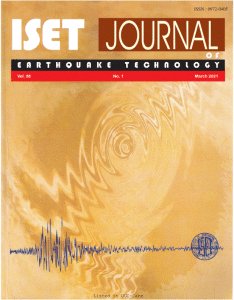Home > Issues & Journals
EFFECT OF VISCOUS, VISCOPLASTIC AND FRICTION DAMPING ON THE RESPONSE OF SEISMIC ISOLATED STRUCTURES
Nicos Makris and Shih-Po Chang·
Paper No.: 379
|
Vol.: 35
|
No.: 4
|
December, 1998
|
pp. 113-141

Abstract
In this paper the efficiency of various seismic isolation systems to protect structures from near-source ground motions is examined. It is first shown that under such motions the concept of equivalent linear damping has limited meaning since the transient response of a structure is more sensitive to the nature of the dissipation mechanism, rather than the amount of energy dissipated per cycle. Subsequently, physically realizable cycloidal pulses are introduced and their resemblance to recorded near-source ground motions is illustrated. The study uncovers the coherent component of some near-source acceleration records and their shaking potential of these records is examined. It is found that the response of structures with relatively low isolation periods is substantially affected by the high frequency fluctuations that override the long duration pulse, therefore the concept of seismic isolation is beneficial even for motions that contain a long duration pulse which generates the large recorded displacements and velocities. Furthermore, although cycloidal pulses can capture many characteristics of the displacement and velocity time histories recorded near the source, they are not dependable motions for structural response analysis. It is recommended that when available, near source records should be used and not their cycloidal approximation. Dissipation forces of friction (plastic) type are very efficient in reducing displacement demands although occasionally they are responsible for substantial base shears. The study concludes that a combination of relatively low viscous ·and friction dissipation forces is attractive since base displacements are substantially reduced without increasing appreciably base shears and superstructure accelerations.
Keywords: Near-Source Ground Motions, Seismic Isolated Structures, Viscous Damping, Hysteretic Damping
©2025. ISET. All Rights Reserved.